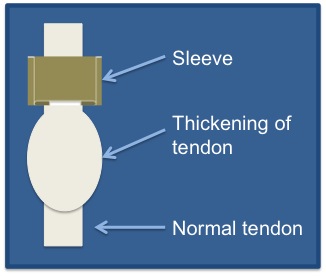What is it?
“Trigger thumb” is a term used to describe a problem affecting the thumb in which it either clicks (or “triggers”) as it is bent and straightened, or more commonly, is stuck in a bent position, and cannot be straightened.
It is thought to affect about 3 children in every thousand. It affects both thumbs in about one third of the children that have the condition.
It is not clear why the problem occurs. It was thought to be something that was present from birth, but we now believe it is a problem that develops in early infancy. Parents usually notice that there is something with the thumb when their child is between the ages of 1 and 3 years.
The problem is due to a mismatch in size between the tendon that causes the thumb to bend, and one of the sleeves through which it runs (see Figure 1). For reasons that we do not understand, the tendon becomes swollen in one area, (which can be felt as a lump at the base of the thumb). When the thickened portion of tendon can just about squeeze through the sleeve, it causes “triggering”, as the thumb is bent and straightened. If the nodule becomes too large to pass through the sleeve, the thumb cannot be straightened from a bent position. This condition is usually completely painless.

Figure 1
What do we do about this?
This depends on how long the problem has been present.
Observation
Sometimes, the problem gets better on its own, and so just watching and waiting is one option, particularly when:
- The child is young (1-2 years)
- The problem has not been present for very long
- The thumb triggers, and is not stuck
- You are not keen on surgery
There is no benefit in using splints or braces; these are very bulky devices, and do not have any proven benefit over just watching and waiting.
Surgery
In older children, and in those who have had the problem for a long time, it is unlikely to improve on its own, and so we perform a small operation to correct it.
In children who have both thumbs affected, surgery is performed on one hand at a time.
This is performed using a general anaesthetic, so that your child is asleep and feels nothing.
The operation takes about 15 minutes, and is minor enough to be performed as a day-stay procedure (provided your child is otherwise well).
A small cut is made in the skin at the base of the thumb. The sleeve is found, and cut open with care. This means that it becomes wide enough for the tendon to pass through it. The skin is then closed with stitches that will dissolve away, so they do not need to be removed.
At the end of the operation, we will inject some local anaesthetic around the operation site to numb the area and provide pain relief. This will last a few hours.
To try and keep the thumb straight, a bulky bandage will be wrapped over the thumb and hand; ideally this should stay on for two weeks, but if it comes off after 5 days, it does not need to be put on again.
The potential complications of this operation are:
- Infection
- Bleeding
- Injury to nearby blood vessels and nerves
- Continued difficulty in straightening the thumb (which may get better with hand therapy, or may need further surgery)
- Recurrence (thumb was moving well, but then begins to trigger again- this will require further surgery)
- Being left worse off than before surgery
Once your child has recovered fully from the anaesthetic, you will be allowed to go home; in the majority of cases that would be the same day. Once the local anaesthetic wears off, your child may feel some pain, but paracetamol or ibuprofen should be strong enough to relieve this.
You will be seen in clinic two weeks after surgery, and the bandages removed (if they are still present). At this stage, we will check that your child can fully straighten the thumb. Occasionally, we will need to refer your child to the hand therapists, who will provide some exercises to improve the movement of the thumb.

